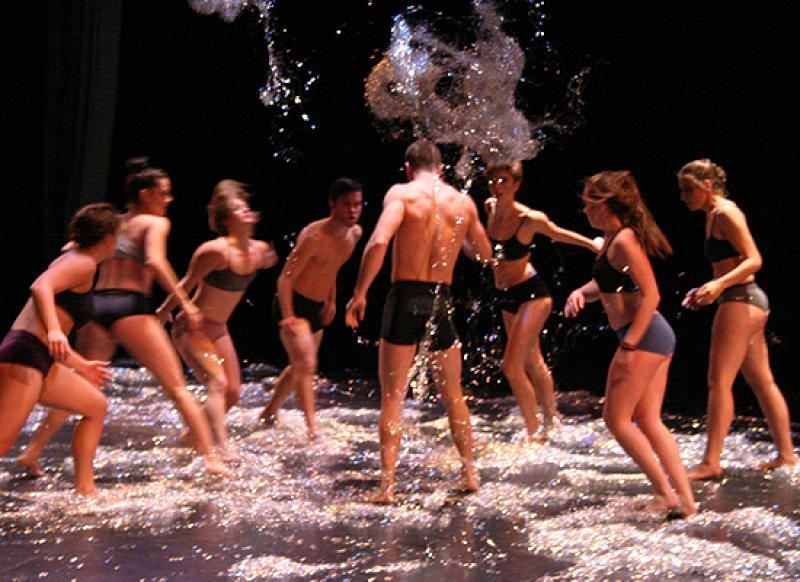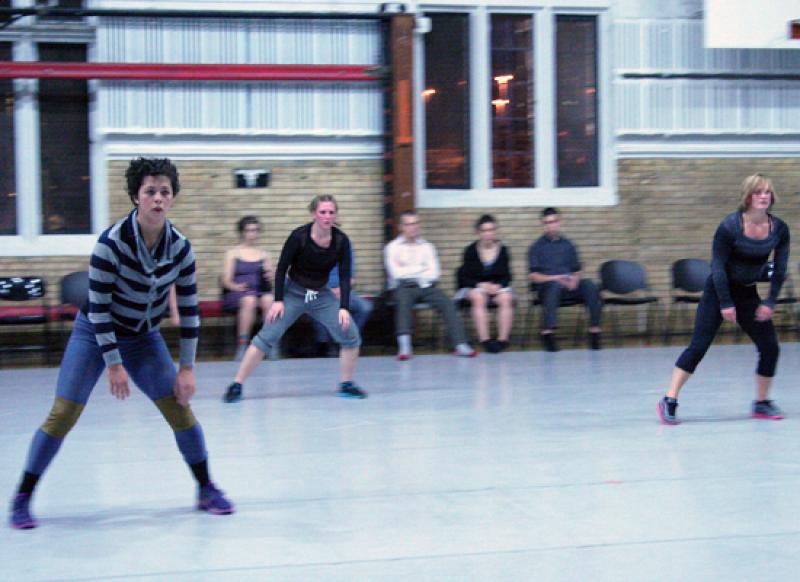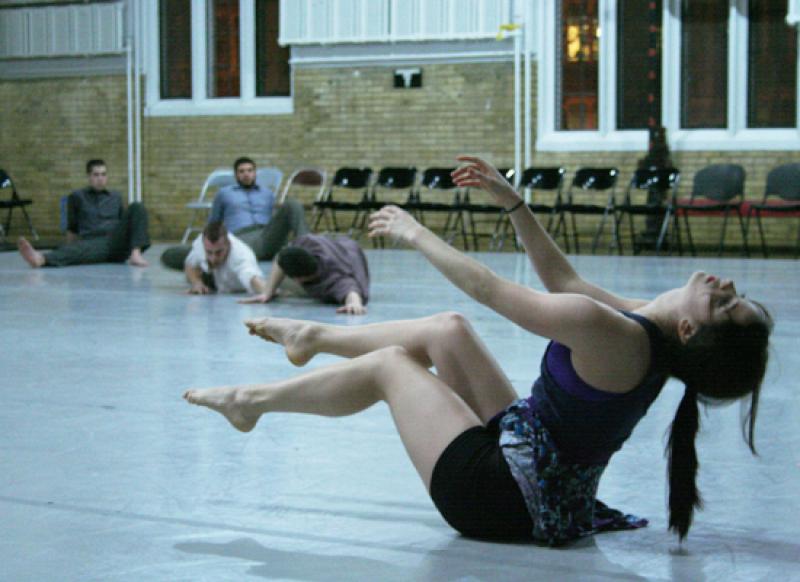Space/People/Dancing/Objects
November 18-19, 2011 at Northland Performing Arts Center
Space/People/Dancing/Objects showcased the culminating work of 3rd year MFA candidates Erik Abbott-Main, Amanda Byars, and Alexis del Sol. The event was presented in November at the Northland Performing Arts Center, formerly a JCPenney department store. Freshly renovated into a multi-use theatre space with a warehouse feel, the venue served as an adaptable site for the choreographer's diverse movement presentations.

Erik Abbott-Main's in the future we'll all be kings was driven by the idea of mythologizing the experiences of today, painting a surrealist picture of a community's call-to-arms. The work challenged the viewer's perception of time, looking forward to the future and backward to the situations that lead us here, allowing for a multiplicity of readings and empathetic experiences to emerge along the way. Presented as a collection of smaller dances in duet, trio and group form, each section offered a visually salient, cross-examination of the space between cause and effect, and lead the viewer to consider notions of confidence, empowerment and companionship. Accompanied by a dissonant sound score arranged by Michael Wall, cinematic lighting by David Covey, and the reflective, atmospheric instillation of tinsel that littered the space, the eight person cast dashed, twitched, and stared, in qualities athletic and ghostlike, toward an otherworld community's liberation.

Amanda Byars Wickens collaborated with visual artist and builder Nicole Bauguss in the sum of their parts to draw attention to the ways in which the performing body is viewed on stage. Byars' movement highlighted the individuals and independent agents in the group making up her five person cast. Using Bauguss' ornate and numerous set pieces, Byars arranged movement segments to minimize or maximize the opportunity for the performer's personality to shine through. Identities were also obscured by designer Emily Jeu's costumes; hooded, long sleeve shirts worked to mask and reveal the performer's faces and limbs at select moments in the dance.

Growing up in New Jersey with Puerto Rican and Cuban parents, Alexis del Sol explored her mixed, complicated heritage in a solo performance, Estoy Nepantla (In Between Two Identities). In this work, del Sol used autobiography, irony and testimony to create a dance depiction of her Latina experience. She considered the ways in which the Latino community contends with its identity on a regular basis: the census, job and financial aid applications, and even first dates. The video portion of the performance, Puertas Deslizantes/Sliding Doors, was a danced documentary that invited the audience members to join in on del Sol's experience of mixed identity. Del Sol also had the pleasure of premiering this work at the Wexner Center for the Arts in collaboration with Alison Vazques (Theatre MFA), Theresa Rojas (English PhD and visual artist) and Indra Leyva-Santiago (video artist) for the Multicultural Center sponsored production, Donde Hay Vida, There is Art.
Rugged Play
February 2-4, 2012 in Pomerene Hall Gym
The Department's Winter MFA concert featured two highly physical works by Abigail Zbikowski and Danté Brown. Pomerene's unconventional, low-tech, in-the-round performance space presented unique challenges and opportunities for the choreographers, dancers, and crew. Video documentation of Rugged Play can be found on the department's Livestream channel.

Abigail Zbikowski's piece, The New Utility, re-envisioned how we appreciate movement in the world by creating a hybrid dance form that drew its inspiration from an eclectic group of motion sources, including: the reckless flailing of bodies in a mosh pit, the coolly controlled whip of a b-boy/girl, and the Zen-like movement patterns of a Zamboni machine cleaning ice. The New Utility called upon the contemporary and street dance skills of its five performers, highlighting not only their physical abilities as movers, but also their dedication to movement and their individual self-discovered grooves. The New Utility was funded by Alumni Grants for Graduate Research and Scholarship (AGGRS). More information on the process can be found on the project blog.

Danté Brown's project, Blind Spots, investigated the choreographic relationship between body and space by examining the physicality behind ideas of intimacy. Researching the ways bodies interact in public and privates spaces, Blind Spots tapped into the physicality of the bodily interactions that we experience daily through performance.
Portraiture and Perception
March 14-30, 2012 at OSU Urban Arts Space
Second Hands and Square Feet by Fiona Lundie. Performed by Brian Koenig, Fiona Lundie, Jennifer Meckley, and David Thill on March 24, 2012 at the Urban Arts Space.
In co-creating this performance installation, MFA candidates Fiona Lundie and Rashana Smith crafted multi-sensory, interactive environments to highlight the relationship between how we gather information (perception) and how we create conceptual identities thereof (portraiture). Lundie and Smith used movement, video, and set constructions to frame, link, and present bodies in space, in time, and in relation to each other.
The exhibit utilized dance, movement, and the body as a way to further understand our interaction with and interpretation of our world, including the ways we conceive and retain sensory, experiential knowledge. Performers and viewers alike traversed and activated the gallery space in order to process the perceptual information. Viewers were provided an engaging, aesthetic environment to inspire greater awareness of their relationships to and agency within their everyday experiences, especially with respect to time, space, and human dynamics.
Local photographer Candace Moser Stafford joined Lundie and Smith by presenting correlating portraiture in the windows of Urban Arts Space. Lundie and Smith also served as artists-in-residence for the OSU Urban Arts Space's monthly children's art activity, Art Explorations, leading creative movement expeditions within the installation and facilitating a complementary flipbook workshop.
Full Circle
January 19, 2012 at the Gateway Film Center
Using beautiful natural settings, Eric Nordstrom's dance film MFA project, Full Circle, combined contact improvisation with a quest for adventure. The film showed the freedom of letting go of our preconceptions and invited viewers to embrace the present moment. While making Full Circle, Nordstrom studied with dance artists such as Nancy Stark Smith and attended video classes through ACCAD, the Department of Art, and the Department of Dance.
Nordstrom was grateful to work with many fantastic collaborators on his project. Artists featured in Full Circle included Ann Cooper Albright, a notable performer, choreographer and feminist scholar. Videographers he worked with included Geoff Schaaf, camera operator for such feature films as The Abyss, and television programs including Lifestyles of the Rich and Famous; and Kent De Spain, recognized internationally for his work as a dance/multimedia artist and researcher. Longtime BodyVox Dance Company collaborator Mitchell Rose, and former Cunningham dancer Karen Elliot advised Nordstrom throughout the project's creation. Full Circle premiered this past winter as part of Dance@30fps, an evening of dance-film organized by Mitchell Rose.
PhD in Dance Studies
As one of the few departments in the country that supports all levels of study, we are fortunate to support students as they engage with many different facets of the discipline. Our doctoral candidates in particular are continually pushing the field of Dance Studies forward in a variety of ways.
This year the Department will graduate our third Doctor of Philosophy in Dance, Jessica Zeller. Dr. Jessica Zeller will leave central Ohio in autumn to join the faculty at Texas Christian University. She will be greatly missed here at OSU. Additionally, three doctoral candidates have passed their candidacy examinations and have begun research towards their dissertations- Veronica Dittman-Stanich, Rachael Riggs Leyva and Mair Culbreth.
Veronica Dittman-Stanich is using postmodern choreographer John Jasperse's Canyon as a jumping-off point, investigating the ways that Jasperse and his dancers, as well as audience members, make sense of such a work. Jasperse and his dancers invest the work with layers of meaning, not only through the choreography and the physicality of their dancing, but also through visual design and textual artifacts, such as press releases and program notes. Each audience member uses his or her own subjectivity to render a performance of Canyon coherent. How do the dance-makers' and audience members' understandings of this particular work overlap, and how do they diverge? This question is what drives Veronica's research. Veronica is joined by two other Dance Studies scholars: Rachael Riggs Leyva, who is combining dance and literacy studies, and Mair Culbreth, who is in the process of defining her research.
This list comprises a brief survey of the Department's emerging dance scholars. We are proud to support the development of their research and look forward to fostering these and other enterprising leaders in the dance community.
- Brian Devine
